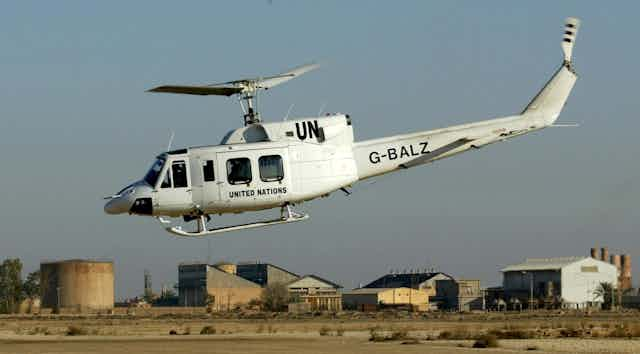After the end of the first Gulf War in April 1991, the United Nations Security Council (UNSC) set up processes to oversee the elimination of Iraq’s weapons of mass destruction. Over the next decade, weapons inspectors demonstrated that – while difficult – internationally verified disarmament is technically possible.
The ceasefire agreement, UNSC Resolution 687, stipulated that Iraq must declare and destroy its chemical and biological weapons and related programmes, as well as missiles with a range of more than 150km. It also required Iraq to give “anytime, anywhere” access to international inspectors and accept long-term monitoring of its territory.
This was not a negotiated agreement – it was a condition for ending hostilities. Until the UNSC agreed that Iraq had complied with the ceasefire agreement, Iraq would be subject to international sanctions.
Resolution 687 also mandated the UNSC to create a special commission (Unscom) to oversee and verify the destruction of Iraq’s chemical and biological weapons and designated missiles. The International Atomic Energy Agency (IAEA) was tasked with verifying the elimination of Iraq’s nuclear weapons capability and set up an Action Team for this. Despite covering separate weapons categories, the two organisations worked closely, with Unscom maintaining overall responsibility for coordinating inspections of undeclared sites in Iraq.
On paper, the ceasefire agreement gave weapons inspectors unprecedented scope and access. In reality, the inspectors met with a high degree of obfuscation. It was immediately obvious that Iraq’s initial declarations were far from complete. There were multiple stand-offs in which the inspectors were refused access to sites, threatened and abused. When they did get access, they frequently found that Iraq had removed key equipment and documentation to avoid detection.
The inspections: technical successes
Despite Iraqi intransigence, the inspectors successfully uncovered significant biological and chemical weapons programmes, as well as a nuclear weapons programme that had been undetected by the IAEA safeguards system which checked compliance with the nuclear Non-Proliferation Treaty (NPT).

They did this by pioneering new techniques, tailoring different approaches to specific detection challenges. Unscom developed a new approach based on assessing the amount of relevant material in Iraq, which involved painstakingly collecting information about weapons and components the country had imported and produced, and comparing it with information on what had been used and eliminated. This helped the inspectors understand what else they needed to find and destroy.
The weapons inspectors were also pioneers in new technologies and applications. They used overflights to track equipment movements and environmental sampling to analyse trace remains of suspected weapons production sites. Weapons inspectors found it useful to be able to compare information about different types of weapons, unlike international treaties which tend to treat different weapons categories separately. At the same time, the inspectors demonstrated the limits of information from defectors and national intelligence agencies.
Political wranglings
Throughout, the inspectors needed to be astute and operate within complicated political situations. Iraq worked to undermine the credibility of inspections and divide the UNSC. Unscom, unique in being a UNSC subsidiary body, found that it needed to invoke the threat of resumed military action to pressurise Iraq into compliance with Resolution 687, although it had to be careful not to overplay this.
The first head of Unscom, Rolf Ekéus, was particularly effective in leveraging support when needed so he could present Iraq with credible threats while not exhausting UNSC patience. Doing so at propitious moments led to Iraq capitulating, and so, although there were airstrikes against Iraq during the 1990s, there were fewer than threatened.

From 1997, things got trickier. Ekéus left Unscom, and his successor had to deal with allegations of spying, which contributed to the body being disbanded and replaced by a less intrusive arrangement, Unmovic. Meanwhile, existing divisions between UNSC members became more pronounced. France and Russia wanted to end inspections and lift sanctions against Iraq earlier than other members, while the US and UK wanted to continue pressuring Iraq to prove that it had irreversibly eliminated its weapons of mass destruction.
Despite these issues, monitoring continued, and the IAEA Action Team and Unmovic repeatedly reported that they could find no evidence of weapons of mass destruction. However, Iraq persisted in impeding inspections and would not accept long-term monitoring. Uncertainty remained, which helped the US make the case for war with Iraq, supported by the UK government. Justified by flawed intelligence and communication processes, this culminated in the 2003 invasion of Iraq.
What happened next?
Unscom, the IAEA Action Team and Unmovic showed that disarmament can be verified to a high degree of confidence. This is supported by what happened next. After the 2003 Iraq War, an Iraq Survey Group was appointed to investigate, which validated the findings that Iraq had no remaining weapons of mass destruction, and undermined earlier problem intelligence assessments.
It is useful to remember these things now. Three decades later, in 2021, the aspirations and prospects for collective arms control and disarmament have been damaged. This is, in part, because of disarmament cynics’ belief that such efforts are impossible to verify. Problems can be seen, for example, in longstanding issues within existing multilateral agreements, such as the Biological Weapons Convention and the NPT, and in the Trump Administration’s unilateral withdrawals from the Open Skies and Intermediate-Range Nuclear Forces treaties.
It was difficult, but possible, for the Iraq inspection regimes to develop systems that provided reliable indicators of Iraq’s non-compliance with the ceasefire agreement. Since then, new open-source investigative tools mean they would now have more options.
But the Iraq inspection regimes also show that effective verification comprises political processes as well as technical systems. The inspections needed UNSC support to ensure full implementation of the ceasefire agreement, and decisions on how to respond to inspection findings needed collective political judgement on satisfactory Iraqi compliance.
The international community would do well to remember this. It could have made better decisions about Iraq in 2003 had it continued to unite in supporting and attending to the international inspections.

